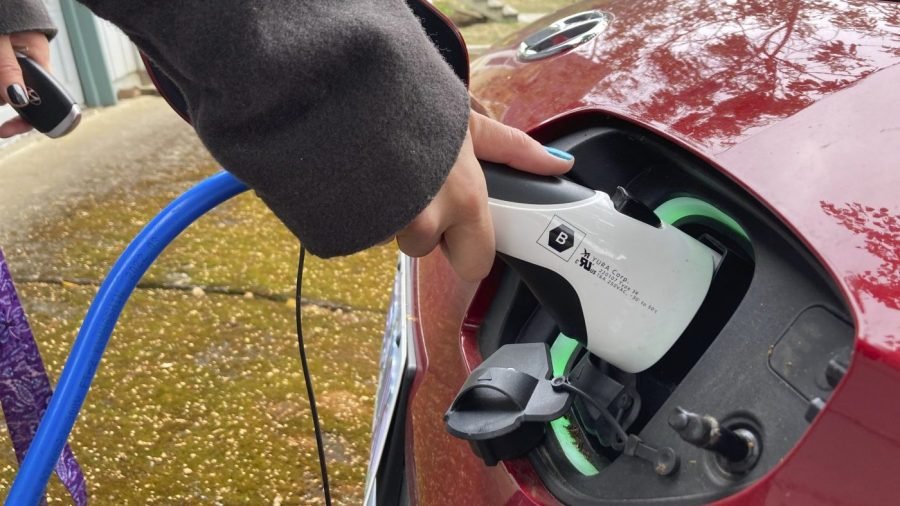
How many people own a gasoline-powered iPhone? The very question is absurd.
Is a gasoline-powered phone possible? Technically, perhaps. But burning fossil fuel to run a precision device is outdated, wasteful and unnecessary — especially when ultra-efficient lithium-ion batteries exist.
And yet, despite those same batteries being widely available to power cars, most of us still get around by lighting a fire under a metal hood and wasting the majority of that energy as heat, noise and pollution. For all of these reasons, electric vehicles are an obvious upgrade over combustion machines — quieter, cleaner, more efficient and easier to maintain.
But instead of leading with that logic, proponents of electric vehicles have turned the conversation into a moral crusade. We have made these cars a symbol of climate virtue instead of everyday utility, and it isn’t working.
Now the industry faces hurdles. Sales are stalling globally. Growth in the U.S. has slowed and in Europe is leveling off after years of gains. Even China — the world’s electric vehicle juggernaut — is showing signs of market saturation.
This is the result of making an emotional pitch instead of a rational one. People don’t want ideology, they want answers. Do electric vehicles make my life easier, cheaper, smarter? They can. But we have to start talking about them differently.
Here’s where the conversation needs to go next to keep the electric vehicle industry growing and make electric vehicles a practical choice for everyone, not just a political statement for a few.
Forget the climate pitch for a second and picture this: You plug in your car at night. By morning, it’s ready to drive — powered by your rooftop solar, costing you nothing at the pump. This isn’t the future — it’s already here.
Nearly 80 percent of electric vehicle charging happens at home. That means no more detours to the gas station or paying a premium to fill up. This direct-to-source energy use puts control back in the hands of the driver.
Pair that electric vehicle with solar panels, and you have something even more powerful: real energy independence. According to the Department of Energy, owners with rooftop solar can drastically reduce their energy bills. In some cases, they can use their cars to power their homes.
This isn’t just convenience. It is a shift away from legacy utility systems. In an era where resilience and self-reliance matter, electric vehicles are potentially a platform for both.
Beyond energy independence and economic logic, electric vehicles offer another immediate, overlooked benefit: cleaner air. Electric vehicles produce no tailpipe emissions. That means no nitrogen oxides, no particulate matter and no smog.
A 2023 study found that higher electric vehicle adoption directly correlates with lower rates of asthma-related emergency room visits. Meanwhile, low-emission zones in cities across Europe have seen air quality improvements and health gains. That still varies based on the source of the electricity, but electric vehicles cut emissions in every global market, even on “dirty” grids. Cleaner air isn’t just nice to have — it’s a direct, everyday reason for electric vehicle adoption, especially in cities where exhaust and asthma go hand in hand.
If electric vehicles still sound futuristic, that’s only because we’ve been stuck in the past. Gas-powered cars rely on controlled explosions and heavy mechanical parts. We literally light stuff on fire to get us where we need to go. It’s not just dirty — it’s wildly inefficient.
Electric vehicles run on electrons, not explosions. They convert into actual movement more than 75 percent of the energy they take in, compared to as little as 12 percent for gasoline engines. The rest of that goes up in heat, noise and wasted motion. You’re burning money every time you hit the gas.
And it’s not just the cars that are getting smarter — the grid is, too. In places like the U.K., all new home chargers must be “smart,” meaning they automatically draw power at times when energy is cheapest and cleanest. U.S. utilities are doing the same with time-of-use pricing, nudging drivers to charge overnight, when demand is low.
Next up? Electric vehicles that don’t just take power, but give it. With vehicle-to-grid tech, your car can become a mobile battery, feeding electricity back into your home or neighborhood during peak hours. According to the National Renewable Energy Laboratory, this kind of bi-directional charging could ease grid strain and lower costs for everyone. So electric vehicles aren’t necessarily a threat to the grid — they can be part of the upgrade.
Look around and you may notice that electric vehicle prices are coming down. What’s less obvious is how they are outperforming gas cars for working-class drivers.
Gig drivers are adopting electric vehicles up to five-times faster than the general population, thanks to fuel savings, lower maintenance and upfront incentives. In such cities as London, Vancouver and Amsterdam, more than one-third of all Uber trip-miles are electric. In New York City alone, there are over 10,000 electric vehicles in the fleets of Uber and Lyft, and that number is set to triple.
These machines are not just luxury toys, as they were often described a few years ago — they are better tools for work. They are more efficient, more reliable and more profitable for the people who drive the most.
People don’t need to feel better about driving electric. They need to understand why it’s the logical, efficient and profitable choice.
Hebron Sher is CEO and founder of Zevo.

